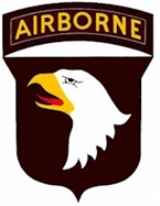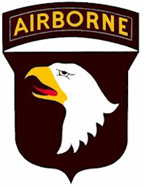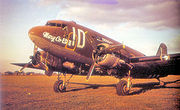
Operation Chicago
Encyclopedia

American airborne landings in Normandy
The American airborne landings in Normandy were the first United States combat operations during Operation Overlord, the invasion of Normandy by the Western Allies on June 6, 1944. Around 13,100 paratroopers of the U.S. 82nd Airborne and 101st Airborne Divisions made night parachute drops early on...
, made by elements of the U.S. 101st Airborne Division
101st Airborne Division
The 101st Airborne Division—the "Screaming Eagles"—is a U.S. Army modular light infantry division trained for air assault operations. During World War II, it was renowned for its role in Operation Overlord, the D-Day landings on 6 June 1944, in Normandy, France, Operation Market Garden, the...
on the early morning of June 6, 1944. It was part of Operation Neptune
Operation Neptune
The Normandy landings, codenamed Operation Neptune, were the landing operations of the Allied invasion of Normandy, in Operation Overlord, during World War II. The landings commenced on Tuesday, 6 June 1944 , beginning at 6:30 AM British Double Summer Time...
, the assault portion of the Allied invasion of France
France
The French Republic , The French Republic , The French Republic , (commonly known as France , is a unitary semi-presidential republic in Western Europe with several overseas territories and islands located on other continents and in the Indian, Pacific, and Atlantic oceans. Metropolitan France...
, Operation Overlord
Operation Overlord
Operation Overlord was the code name for the Battle of Normandy, the operation that launched the invasion of German-occupied western Europe during World War II by Allied forces. The operation commenced on 6 June 1944 with the Normandy landings...
. Originally slated to be the main assault for the 101st Airborne, the glider operation instead became the first reinforcement mission after the main parachute combat assault, mission Albany
Mission Albany
Mission Albany was a parachute combat assault at night by the U.S. 101st Airborne Division on June 6, 1944, part of the American airborne landings in Normandy. It was the opening step of Operation Neptune, the assault portion of the Allied invasion of France, Operation Overlord...
. Because the area of responsibility for the division was in close proximity to Utah Beach
Utah Beach
Utah Beach was the code name for the right flank, or westernmost, of the Allied landing beaches during the D-Day invasion of Normandy, as part of Operation Overlord on 6 June 1944...
, the use of glider reinforcement was limited in scale, with most division support units transported by sea.
Overview
The 101st Airborne Division's objectives were to secure the four causeway exits behind Utah BeachUtah Beach
Utah Beach was the code name for the right flank, or westernmost, of the Allied landing beaches during the D-Day invasion of Normandy, as part of Operation Overlord on 6 June 1944...
, destroy a German coastal artillery battery at Saint-Martin-de-Varreville, capture buildings nearby at Mezières believed used as barracks and a command post for the artillery battery, capture the Douve River lock at la Barquette (opposite Carentan), capture two footbridges spanning the Douve River at la Porte opposite Brevands, destroy the highway bridges over the Douve at Sainte-Come-du-Mont, and secure the Douve River valley.
In the process units would also disrupt German communications, establish roadblocks to hamper the movement of German reinforcements, establish a defensive line between the beachhead and Valognes, clear the area of the drop zones to the unit boundary at Les Forges, and link up with the 82nd Airborne Division.
Mission description

C-47 Skytrain
The Douglas C-47 Skytrain or Dakota is a military transport aircraft that was developed from the Douglas DC-3 airliner. It was used extensively by the Allies during World War II and remained in front line operations through the 1950s with a few remaining in operation to this day.-Design and...
s of the 434th Troop Carrier Group at RAF Aldermaston
RAF Aldermaston
RAF Aldermaston was a World War II airfield. It was used by the Royal Air Force and the United States Army Eighth and Ninth Air Force as a troop carrier group base, and was assigned USAAF station No 467.-Origins:...
. 52 aircraft acted as tugs for an equal number of CG-4A Waco gliders carrying 155 troops, a bulldozer
Bulldozer
A bulldozer is a crawler equipped with a substantial metal plate used to push large quantities of soil, sand, rubble, etc., during construction work and typically equipped at the rear with a claw-like device to loosen densely-compacted materials.Bulldozers can be found on a wide range of sites,...
, sixteen 57-millimeter (6-pounder) antitank guns, and 25 small vehicles. 2.5 tons of ammunition and 11 tons of equipment were also transported, including an SCR-499 radio set for the division headquarters command post.
Chicago was primarily an artillery reinforcement mission. Aboard 44 gliders were Batteries A and B of the 81st Airborne Antiaircraft Battalion. The other 8 gliders carried small elements of the 326th Airborne Engineer Battalion, the 101st Signal Company, the antitank platoon of the 327th Glider Infantry Regiment, and a surgical team
Surgery
Surgery is an ancient medical specialty that uses operative manual and instrumental techniques on a patient to investigate and/or treat a pathological condition such as disease or injury, or to help improve bodily function or appearance.An act of performing surgery may be called a surgical...
of the 326th Airborne Medical Company. Also accompanying the glider serial in a last-minute change was the assistant division commander, Brig. Gen. Don F. Pratt
Don Pratt
Don Forrester Pratt was a United States Army general in World War II. He was Assistant Division Commander of the 101st Airborne Division and was the highest-ranking Allied officer killed on D-Day of the Normandy Landings....
, who had been designated to command the seaborne echelon.
The mission had originally been planned for glider release at civil twilight
Civil twilight
Civil twilight can mean:* The brightest phase of twilight.* Civil Twilight , three-piece rock music band who originated in Cape Town, South Africa before moving to the USA.* "Civil Twilight", a song by The Weakerthans from their 2007 album Reunion Tour....
on the evening before the amphibious landings, but to protect the gliders from ground fire the time was changed on May 27 to 0400 on D-Day, 2 hours before dawn. The designated destination in France was Landing Zone (LZ) E, an area co-located with and slightly overlapping one of the paratroop drop zones, DZ C. The area was chosen as central to the operations of the division and because a BUPS beacon ("Beacon, Ultra Portable S-band
S band
The S band is defined by an IEEE standard for radio waves with frequencies that range from 2 to 4 GHz, crossing the conventional boundary between UHF and SHF at 3.0 GHz. It is part of the microwave band of the electromagnetic spectrum...
") was to be in place there on which the serial commander could guide using the SCR-717 search radars installed in the aircraft of flight leaders.
The landing zone was a triangle-shaped area a mile in width at its mile-long base along the road connecting les Forges (a hamlet south of Sainte-Mère-Église
Sainte-Mère-Église
Sainte-Mère-Église is a commune in the Manche department in Normandy in north-western France.-History:Founded in the eleventh Century, the earliest records include the name Sancte Marie Ecclesia, Latin for "Church of St. Mary", while a later document written in Norman-French mentions Saincte...
) and Sainte-Marie-du-Mont
Sainte-Marie-du-Mont, Manche
Sainte-Marie-du-Mont is a commune in the Manche department in Normandy in north-western France.-World War II:It is best known for being the scene of military engagement between the American 101st Airborne Division and the German Wehrmacht on D-Day, June 6, 1944.-Heraldry:-References:*...
. The zone was 1.5 miles (2.4 km) in depth and its eastern edge ran through Hiesville, the division command post two miles (3 km) west of Ste. Marie-du-Mont. In addition to its central locality, the fields within the zone were on average twice the length of most others in the vicinity. Many of the fields, however, were bordered by trees 40 feet (12.2 m) in height and not hedgerows, a fact that did not show up well on aerial reconnaissance photographs.
Glider assault
The first of 52 aircraft took off at 0119. Bright moonlight enabled the tugs to assemble in thirteen flights of four aircraft-glider combinations in an "echelon of four to the rightEchelon formation
An echelon formation is a military formation in which members are arranged diagonally. Each member is stationed behind and to the right , or behind and to the left , of the member ahead...
" formation. Shortly after assembly the glider carrying the command post radio broke loose from its tug and landed. The radio was retrieved and transported that evening in mission Keokuck, but the accident meant that the 101st would be out of radio contact with other invasion forces until after link-up with the U.S. 4th Infantry Division
U.S. 4th Infantry Division
The 4th Infantry Division is a modular division of the United States Army based at Fort Carson, Colorado, with four brigade combat teams. It is a very technically advanced combat division in the U.S. Army....
coming off Utah Beach.
The weather along its route had moderated from the dense cloud bank and ground fog that had severely disrupted the parachute drops two hours earlier. Because they were in trail and not in close formation vees, the tugs and gliders were able to penetrate the clouds without losing formation. The columns drew ground fire, however, and one C-47 and its glider went down near Pont l'Abbé on the Douve River, west of the landing zone. Seven transports and several gliders also incurred damage.
The commander of the 434th TCG was guided to LZ E by a "Eureka
Eureka beacon
The Rebecca/Eureka transponding radar was a transponder system used as a radio homing beacon by means of a Eureka ground emitter responding to queries from an airborne Rebecca interrogator.-Operation:...
" transponding radar
Transponder
In telecommunication, the term transponder has the following meanings:...
beacon set up there by the pathfinder
Pathfinders (military)
A pathfinder is a paratrooper who is inserted or dropped into place in order to set up and operate drop zones, pickup zones, and helicopter landing sites for airborne operations, air resupply operations, or other air operations in support of the ground unit commander...
s (the BUPS AN/UPN-1
AN/UPN-1
The AN/UPN-1 was a radar Pathfinder marker beacon used by the Army Air Force and Airborne forces during World War II.-Use:Radar beacon AN/UPN-1, sometimes known as BUPS , is an ultra portable beacon for ground, Paratroop or shipboard use having a range of 35 to 50 miles...
beacons had been damaged in landing and were inoperable). Although it had been placed in the wrong section of the LZ, the 'Tee' shape formed by green Holophane
Holophane
Holophane is a part of Acuity Brands. Holophane is one of the oldest manufacturers of lighting-related products in the world; founded in 1898 in London, England. They are a UK and US manufacturer of lighting fixtures for commercial, industrial, outdoor, and emergency applications...
marker lights was observed by pilots of the arriving C-47s. At 0354, six minutes early, 49 of the 50 remaining pilots released their gliders at the designated point from an altitude of 450 feet (137.2 m) MSL
Sea level
Mean sea level is a measure of the average height of the ocean's surface ; used as a standard in reckoning land elevation...
. The 50th, wandering out of formation, released its glider south of Carentan.
During the specified 270° left turns after release, most of the Waco glider pilots lost sight of the marker lights. The moon was setting by release time and obscured by scattered clouds so that without reference to the markers the glider pilots no longer recognized the landing zone. Just six landed on the LZ itself and only 15 others in fields within a half mile. A group of ten landed in a field near les Forges. Of the remaining 18, all but one landed in fields to the east within two miles (3 km).
Almost all crash-landed in the smaller fields outside the LZ after overshooting to clear unexpected trees. German ground fire was ineffective in the dark, and even though most gliders struck a tree or ditch, most loads were successfully landed without harm. In one glider Gen. Pratt was killed along with the co-pilot (the aftermath of this incident is fictionalized in the film Saving Private Ryan
Saving Private Ryan
Saving Private Ryan is a 1998 American war film set during the invasion of Normandy in World War II. It was directed by Steven Spielberg, with a screenplay by Robert Rodat. The film is notable for the intensity of its opening 27 minutes, which depicts the Omaha Beach assault of June 6, 1944....
). Total casualties were 5 dead, 17 injured, and 7 missing.
At dawn the division command post sent out a large patrol to assist the reinforcements in removing their equipment from the crushed gliders (very few were crushed so badly that the equipment could not be removed immediately) and to guide them to Hiesville. Collecting and assembling the equipment was a lengthy process, but at noon the patrol returned with 3 jeeps, 6 AT guns, 115 glider troops, and 35 German prisoners. A USAF history of the airborne landings concluded that Mission Chicago had "succeeded beyond expectation".
Sources
- Warren, Dr. John C. USAF Historical Study 97: Airborne Operations in World War II, European Theater (1956). Air University.
- U.S. Airborne in Cotentin Peninsula

